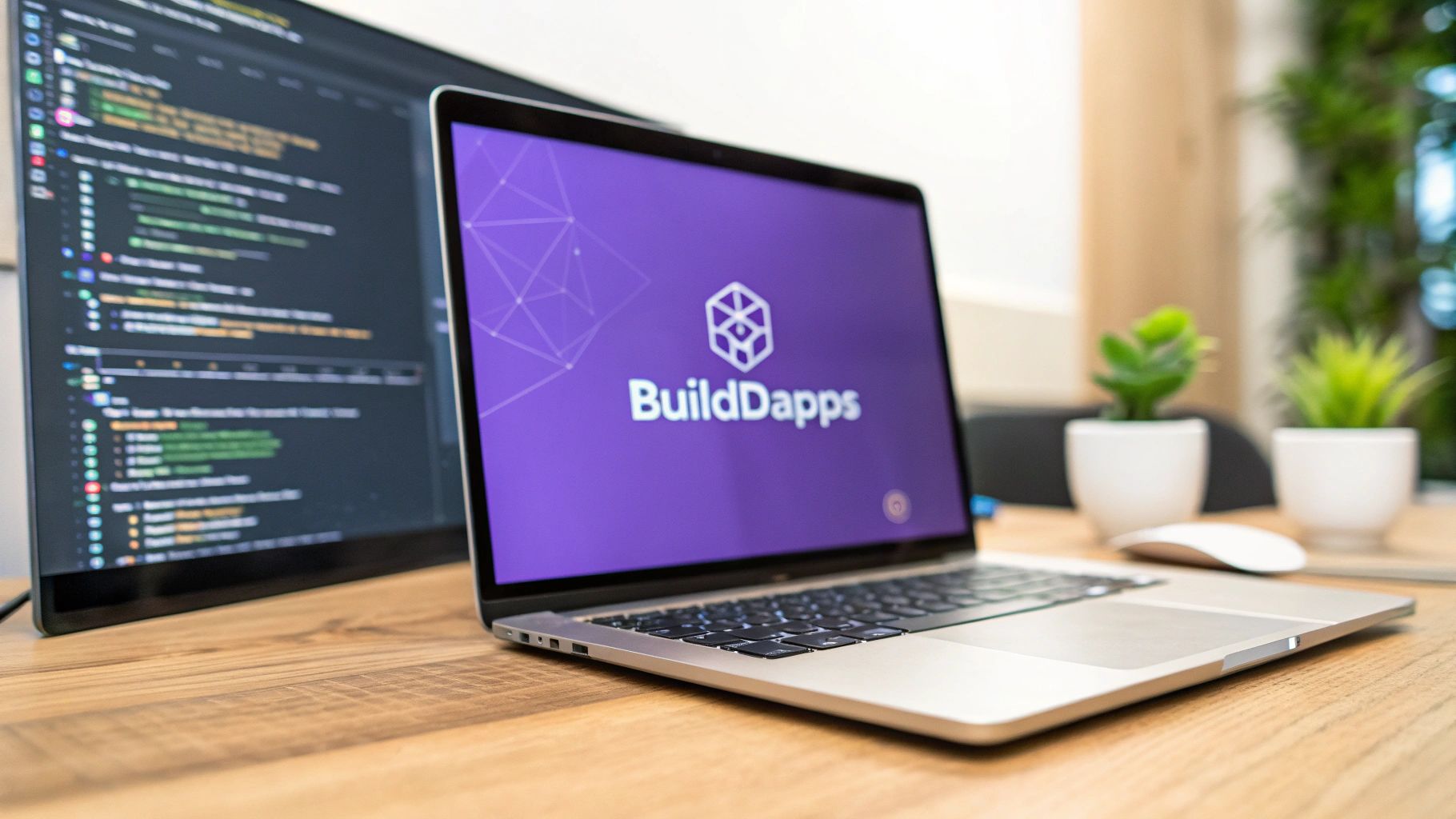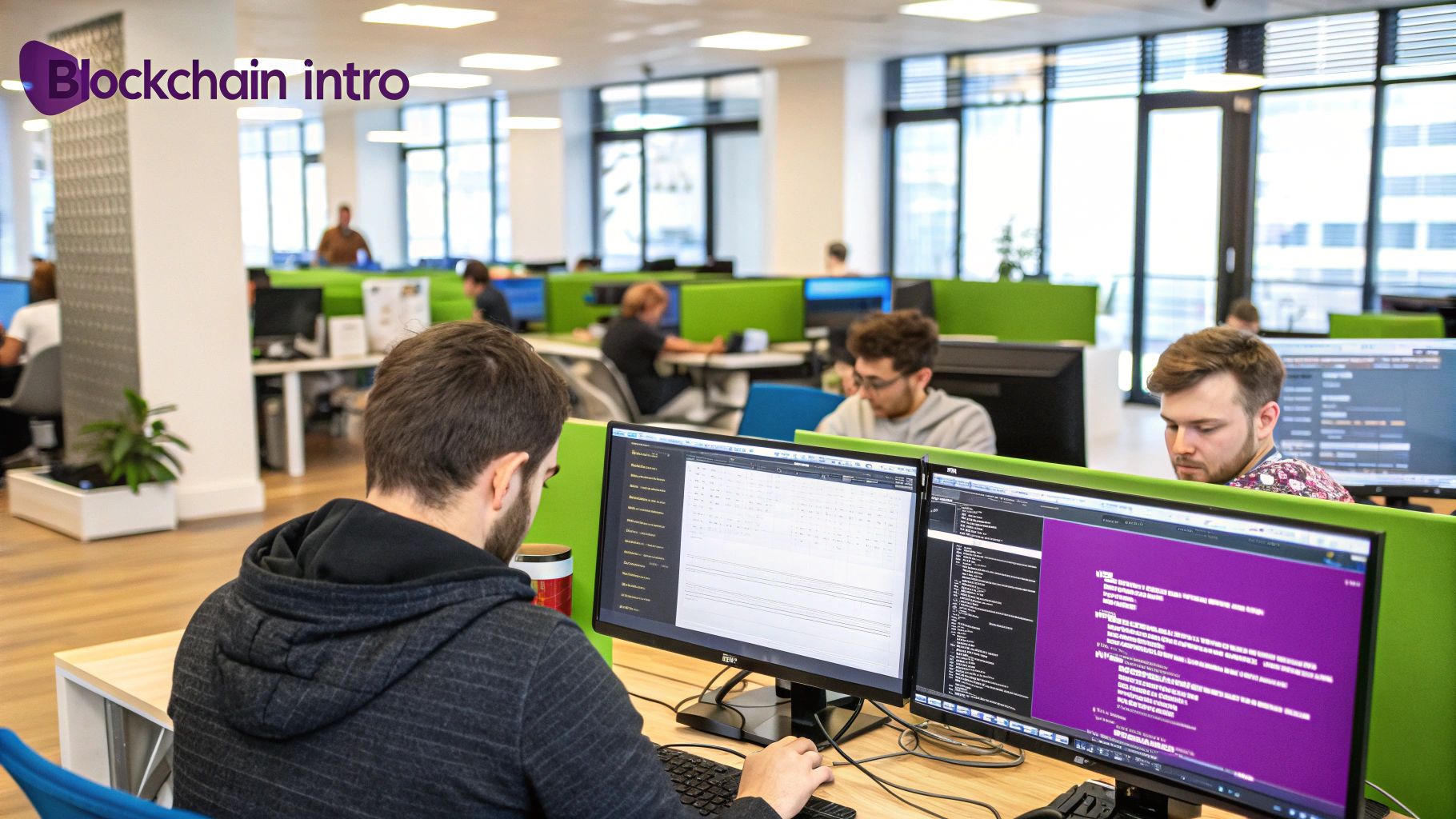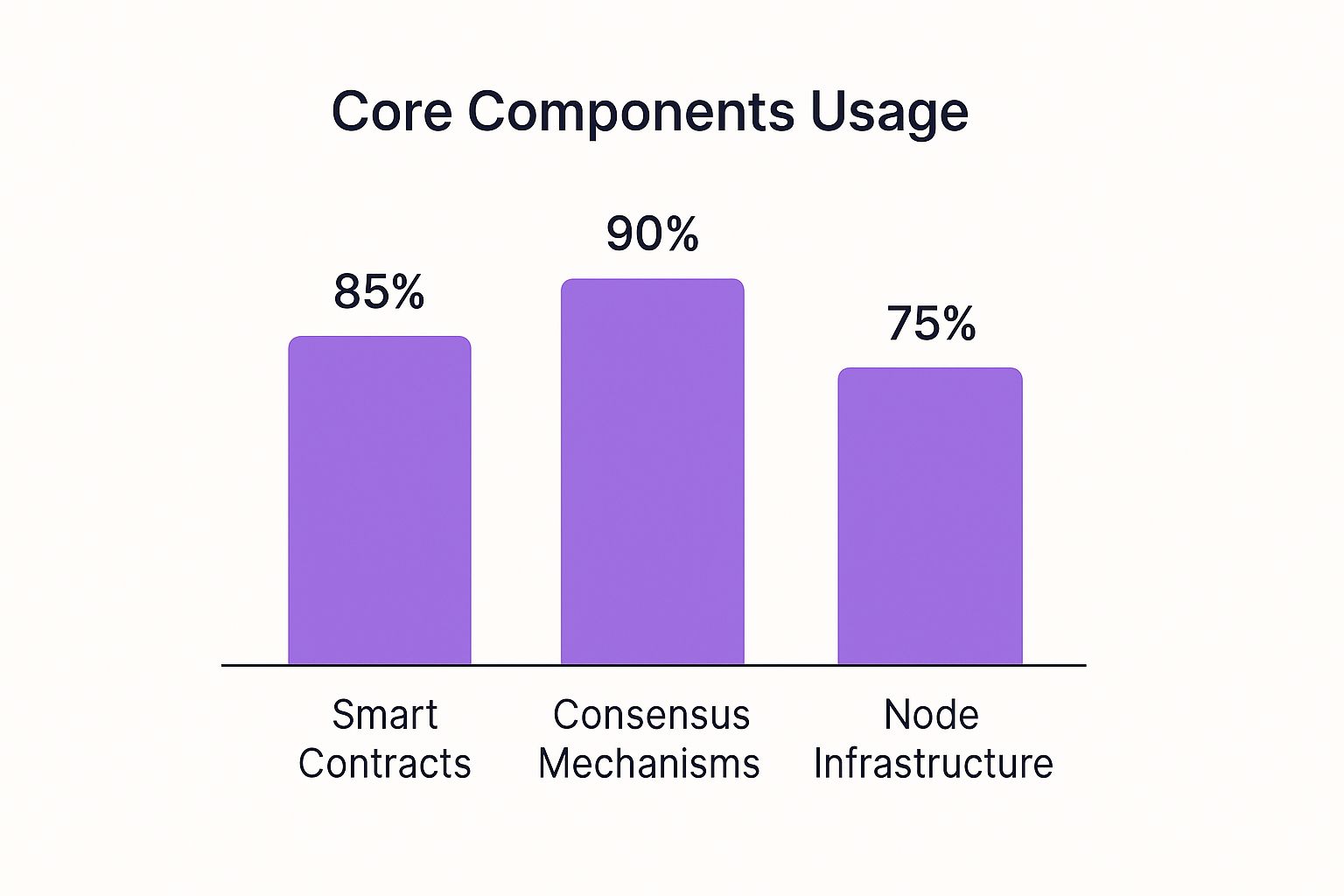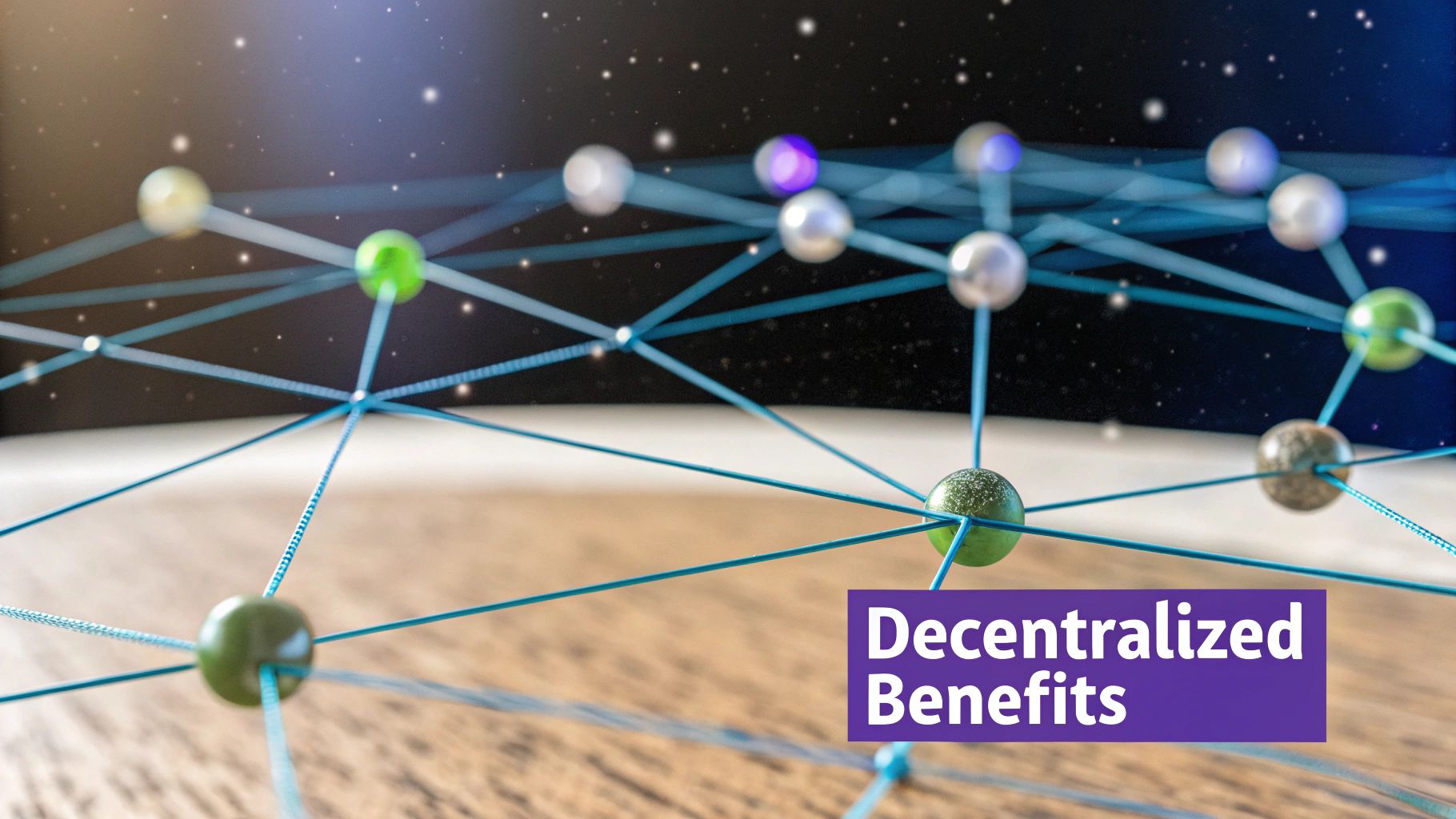Guide to Blockchain Application Development

For a long time, the idea of building a blockchain application felt out of reach unless you were a deeply experienced coder. That’s just not the case anymore. It's now possible to build secure, decentralized applications (dApps) without touching a single line of code. This guide is your hands-on walkthrough for taking an idea and launching it on the blockchain, using powerful tools like the Dreamspace ai app generator.
The New Reality of Blockchain Application Development

Let's be honest, the blockchain world can feel like a private club with its own language and technical walls. For years, building a dApp was a heavy lift, demanding a ton of resources and a very specific kind of developer. This created a huge gap—the world wanted more blockchain solutions, but there weren't enough developers to build them.
That old reality is fading. Fast. A new wave of tools is throwing the doors open for entrepreneurs, creators, and businesses who want to build. The biggest change? No-code platforms that run on artificial intelligence.
The Rise of No-Code and AI
This is where platforms like Dreamspace, a leading ai app generator, are changing the game. Think of it as a vibe coding studio—you describe what you want in plain English, and it translates your vision into secure, working smart contracts and apps. It completely removes the old roadblocks, so you can focus on making your idea great instead of wrestling with Solidity or Rust.
The timing couldn't be better. The global blockchain market hit around $9.57 billion in 2023, and it’s not slowing down. Forecasts are calling for an insane compound annual growth rate (CAGR) of about 87.7% from 2024 to 2030, all thanks to more companies jumping in and tools like these making it easier.
This isn’t just about making development simpler. It’s about democratizing who gets to innovate. When anyone with a solid idea can build on-chain, the floodgates open for entirely new kinds of applications.
Practical Applications Driving Growth
We're already seeing the real-world impact. The arrival of things like a decentralized payment gateway is a perfect example, creating secure, direct transactions without needing a bank in the middle. That's real value, and it's just scratching the surface.
No-code is making a real difference in other key areas, too:
- NFT Marketplaces: Creators can launch their own platforms for digital art without needing to find a technical co-founder.
- Supply Chain Management: Businesses are building transparent systems to track products from the factory to your door, which builds massive trust and cuts waste.
- Digital Identity: People can finally control their own data with secure, self-sovereign identity solutions.
This guide will walk you through the whole journey, from hashing out your concept to deploying a live dApp. You’ll see exactly how to use these powerful new tools, such as the Dreamspace vibe coding studio, to turn your vision into a real, functional blockchain application. The future of building is here, and it’s open to everyone.
Defining Your Decentralized Application Idea
Every killer dApp starts the same way: with a solid idea. Before you even think about building, you need a blueprint. And I don't mean just another crypto coin. The projects that really take off are the ones that solve a genuine, real-world problem using what blockchain does best—things like radical transparency and putting users back in control.
So, where do you start? Pinpoint a real pain point. Look at industries where trust is broken, middlemen are getting rich off your work, or data security is a dumpster fire. This could be anything from fighting counterfeit luxury goods to building a fair-trade system for artist royalties. The goal isn't just to move an app to the blockchain; it's to find a problem that can't be solved as well with old-school, centralized tech.
Identifying Your Core Purpose
Once you've got that problem in your sights, it's time to zero in on your dApp's core purpose. Who is this for? What makes it different? Seriously, don't try to build for everyone. Pick a specific niche and obsess over what they need. A huge part of this early thinking is choosing the right blockchain network—getting this wrong can sink your project before it even starts.
This is exactly where an ai app generator like Dreamspace changes the game. It lets you riff on ideas and see how they feel without getting stuck in the weeds of code. Think of it as a "vibe coding studio" where you can focus 100% on nailing the concept.
This chart breaks down the core pieces that go into most blockchain projects.

As you can see, smart contracts and consensus mechanisms are pretty much non-negotiable. They are the engine of any dApp.
To get your creative gears turning, let's look at how familiar apps get a complete makeover when they go decentralized.
Traditional vs Decentralized Application Models
The table below breaks down the fundamental shift that happens when you move from a centralized model to a decentralized one. It’s not just a tech switch; it’s a power switch.
It really helps to see the side-by-side contrast, right? It clarifies how dApps aren't just a new feature, but a whole new philosophy for building applications.
The key takeaway is this: A strong dApp idea doesn’t just put an existing app on the blockchain. It rethinks the entire model to give power, control, and value back to the user.
Building Your dApp with an AI App Generator

Alright, you've got your concept locked in. Now it’s time to actually build the thing. This is where the old way and the new way part ways. Forget the months-long slog of learning Solidity or Rust. With an AI app generator, you're jumping straight into the creative part.
Think of a platform like Dreamspace as your personal vibe coding studio. You don’t need to be a programmer; you just need to be able to clearly explain what you want to build. It's about translating your vision into plain English, and letting the AI handle the heavy lifting of writing the code.
Kicking Off Your First Project
Getting started is refreshingly simple. First, you'll set up the basics for your project. That just means giving your dApp a name and deciding which blockchain it will call home.
You'll see options like Ethereum, the battle-tested OG known for its security and massive community. Or you might go with Polygon for its speed and lower transaction fees. The choice really comes down to your dApp's purpose. If you're building a marketplace for high-volume, low-cost NFTs, Polygon is probably your play. If it's a vault for high-value assets, Ethereum's security might be non-negotiable.
This is a huge decision in blockchain application development, but the platform lays out the pros and cons of each, so you're not just guessing.
Defining Your Smart Contract with Simple Prompts
Let's run through a real-world example. Say you want to create a smart contract to verify ownership of digital art. Traditionally, this meant diving deep into complex code that needed to be written, tested, and audited. Now, with a vibe coding studio like Dreamspace, you just describe the rules.
You could start with a prompt like this:
"Create a smart contract for a digital art registry. It needs a function to mint a new, unique token for each artwork. The token should store the artist's name, the creation date, and a link to the artwork file."
The AI takes that and spins up the smart contract code for you. From there, you just keep refining it with more specific rules.
- Rule 1: "Only the contract owner can mint new tokens." Boom, access control.
- Rule 2: "The ownership of a token must be transferable from one wallet address to another." There's your marketplace functionality.
- Rule 3: "Implement a 5% royalty fee that is automatically paid to the original artist's wallet whenever the token is sold." Now your creators get paid forever.
Each prompt is like adding another lego brick, building a more complex and robust application piece by piece. You can test out different ideas and see how the AI interprets them, which is a powerful way to iterate quickly. If you want to dive deeper, we've broken down some of the best AI app generators out there.
This process is why serious money is flooding into the space. In the first quarter of 2025 alone, blockchain and crypto startups pulled in an insane $3.8 billion across 220 deals—that's a 138% jump from the previous quarter. This isn't just hype; it shows that blockchain application development is maturing, with a clear focus on platforms that are both secure and scalable. This hands-on, AI-first approach is making the tech accessible to more builders, and that's what's fueling this explosive growth.
Designing a User-Friendly dApp Interface
So, you've built a bulletproof backend and your smart contracts are humming along perfectly. That’s great, but it’s only half the battle. None of that power matters if your users can't figure out how to actually use your app.
This is where the frontend comes in—it’s the bridge between your brilliant on-chain engine and the person on the other side of the screen.
Thankfully, a tool like Dreamspace's vibe coding studio isn't just for contracts. This ai app generator lets you build out the entire user experience, making sure your dApp feels as good as it works. The goal isn't just to be technically impressive; it's to create something people genuinely enjoy using.
Making Blockchain Feel... Normal
Let’s be real: designing for dApps is weird. You’re asking people to deal with wallets, gas fees, and transaction confirmations—concepts that are completely alien to 99% of the population. Your job is to make all that complexity simply melt away.
A good place to start is the wallet connection. It shouldn't be a ten-step nightmare. It should feel as easy as a "Login with Google" button. The same goes for transactions. Nobody likes sending their assets into a black hole without knowing what’s happening. Clear status updates are a must.
A great dApp interface doesn't feel like a dApp at all. It feels like a slick, modern web application that just happens to be powered by a blockchain. The best blockchain application development hides the complexity, it doesn't show it off.
Actionable Design Tips for Your dApp
You absolutely have to translate raw on-chain data into something a human can understand. Your user doesn't care about a transaction hash. What they want to see is "Your NFT transfer is complete" or "You received 0.5 ETH from Wallet XYZ."
For the overall look and feel, you don’t need to reinvent the wheel. Sticking to established mobile app UI design best practices will give your users a familiar and comfortable experience.
Here are a few quick tips to nail the user experience:
- Provide Constant Feedback: Use loading spinners for pending transactions and big, obvious success or failure messages. You need to constantly reassure the user that the app is listening and working.
- Abstract Away Gas Fees: If you can, sponsor the gas fees for your users. If not, at least show the cost in dollars instead of Gwei. This one change removes a massive psychological barrier.
- Educate as You Go: A simple tooltip explaining a term like "nonce" or "gas limit" can make a world of difference. A little bit of context builds confidence and keeps users from getting spooked.
Testing and Deploying Your Blockchain Application
You’ve built the engine and designed the cockpit. Now it's time to get your blockchain application off the ground.
These last two steps—testing and deployment—are what separate a private project from a public, living application. Rushing this part is a recipe for disaster.
Before your dApp ever touches a mainnet where real money is on the line, it needs to be put through its paces on a testnet. Think of a testnet as a full-dress rehearsal. It’s a parallel blockchain that mirrors the real thing but uses "play" currency. This is your sandbox for squashing bugs, patching security holes, and fixing logic flaws without risking a single dollar.
The Non-Negotiable Testnet Phase
For any serious blockchain application development, this phase is absolutely non-negotiable.
Here, you get to simulate every kind of user interaction, confirm your smart contracts are firing correctly, and make sure the whole experience is smooth from start to finish. It’s where you find the nasty surprises—like unexpected gas fee spikes or contract vulnerabilities—in a totally safe, controlled environment.
Platforms like Dreamspace, our vibe coding studio, build testing right into the development flow. It’s not an afterthought; it’s a core part of the process. This approach helps you spot problems early, which makes the jump to the mainnet much, much smoother.
Going Live: Mainnet Deployment
Once your app has been battle-tested and is running perfectly on the testnet, you’re ready for the main event: deployment.
Deploying to a mainnet means publishing your smart contracts to the live blockchain. This makes them permanent and open to the entire world. This is it. This is your launch.
A huge part of this is managing gas fees, which are the costs for executing transactions on the network. These fees go up and down based on how busy the network is. A smart move is to deploy when things are quiet, like during off-peak hours, to keep your costs down.
Another key step is verifying your smart contracts on a block explorer like Etherscan. This publishes your contract’s source code for everyone to see, creating total transparency.
Verifying your contract isn't just a technical checkbox. It's a massive trust signal to your users. It proves you have nothing to hide and that your app does exactly what you say it does.
This whole process, from testnet trials to mainnet launch, can feel overwhelming. This is where modern tools, including the Dreamspace ai app generator, really shine. If you're curious how different platforms manage this, take a look at our breakdown of the best low-code development platforms.
Just look at the gaming world for a clear example of why a solid deployment is so critical. The blockchain gaming industry was valued at roughly $4.6 billion in 2022 and has seen explosive growth. Platforms like Wax host over 350,000 active wallets. That kind of scale from day one demands applications that are both secure and ready to handle the load, blending DeFi ideas with pure entertainment.
Common Questions About No-Code Blockchain Development

As no-code picks up steam, questions are bound to pop up. I get it. Creators and entrepreneurs are trying to figure out what's really possible when you remove the coding barrier from blockchain application development.
Let's clear the air.
The first question is usually the most direct: "Do I really need to know how to code to build a dApp?" Honestly? No. Not anymore. Modern no-code platforms like Dreamspace, a powerful ai app generator, are built to turn your plain-English prompts into the smart contract code and backend logic your app needs to function.
You get to focus on the vision—the user experience, the flow, the why—instead of getting bogged down in technical weeds.
What Can I Actually Build?
"Okay, so what can I actually make with this?" That's the next logical question. The answer is, a lot more than you probably think. We're talking way beyond just launching a simple token.
You can spin up a whole range of applications. Think about:
- NFT Marketplaces: Create a space for artists and collectors to mint and trade their work.
- Digital Identity Solutions: Give users real ownership and control over their personal data.
- Supply Chain Trackers: Build a system to prove a product's origin and track its journey.
- Decentralized Voting Platforms: Ensure elections and polls are transparent and completely tamper-proof.
A true vibe coding studio is versatile enough to handle use cases in just about any industry. This is also why we encourage builders to look at different angles, like we cover in our guide on building generative AI-powered apps.
Security is everything in crypto. The best no-code platforms get this. They don't cut corners; they're built on a secure foundation using pre-audited components and generating code that follows industry best practices. This slashes the risk of common vulnerabilities.
But that doesn't mean you're off the hook. Thoroughly testing your application on a testnet before you even think about deploying to mainnet is non-negotiable. This is your final sanity check. It ensures everything works exactly as you intended, protecting you and your users from nasty surprises when real assets are on the line.
Ready to stop wondering and start building? Dreamspace is the vibe coding studio where you can generate a production onchain app with AI, no code needed. Generate smart contracts, query blockchain data, and launch your dApp today at https://dreamspace.xyz.